
Am Fam Physician. 2019;100(5):290-294
The full text of the POEMs discussed in this article is available at https://www.aafp.org/journals/afp/content/top-poems/2018-cw.html.
Author disclosure: No relevant financial affiliations.
In this article, we discuss the POEMs (patient-oriented evidence that matters) of 2018 judged to be most consistent with the principles of the Choosing Wisely campaign. We selected these POEMs through a crowdsourcing strategy of the daily POEMs information service for Canadian Medical Association's physician members. We present recommendations from these top POEMs of primary research or meta-analysis that identify interventions to consider avoiding in practice. The recommendations cover musculoskeletal conditions (e.g., avoid decompression surgery for treatment of subacromial shoulder pain), respiratory disease (in mild asthma, do not routinely prescribe a long-term daily inhaled steroid over the as-needed use of budesonide/formoterol), infections (e.g., in children with acute respiratory tract infection, do not routinely prescribe broad-spectrum antibiotics over narrow-spectrum antibiotics), and cardiovascular disease (e.g., avoid blanket testing of cardiac troponin in patients with a low pretest likelihood of myocardial infarction). These POEMs describe interventions whose benefits are not superior to other options, are sometimes more expensive, or put patients at increased risk of harm. Knowing more about these POEMs and their connection with the Choosing Wisely campaign will help clinicians and their patients engage in conversations better informed by high-quality evidence.
A POEM (patient-oriented evidence that matters) is a synopsis of a research study that reports patient-oriented outcomes, such as improvement in symptoms, quality of life, or mortality; is free of important methodologic bias; and recommends a change in practice for many physicians. In this article, we discuss the POEMs of 2018 that were most consistent with principles of the Choosing Wisely campaign, an international effort to reduce unnecessary medical tests, treatments, and procedures. Unlike articles where experts choose the top research papers of the year, our crowdsourcing method allows us to identify new studies about clinical actions most consistent with Choosing Wisely, from the perspective of the physician in everyday practice.1,2
In brief, our crowdsourcing method to identify the top POEMs of 2018 consistent with Choosing Wisely is based on physician ratings of the daily POEMs delivered in the context of a continuing medical education program. On average, we received 1,574 physician ratings for each of the 255 unique POEMs in 2018 delivered to members of the Canadian Medical Association. Using these ratings, we compiled a list of top POEMs, which we previously summarized in American Family Physician.3 In this article, we now present the top POEMs of 2018 whose findings were judged to help reduce overdiagnosis or overtreatment in clinical practice and are thus consistent with the principles of the Choosing Wisely campaign.
Note that 13 of the top POEMs of 2018 also ranked at the top for Choosing Wisely. We do not rediscuss these POEMs in this article, but they are summarized in eTable A. In addition, all articles in the top POEMs series are available at https://www.aafp.org/afp/toppoems.
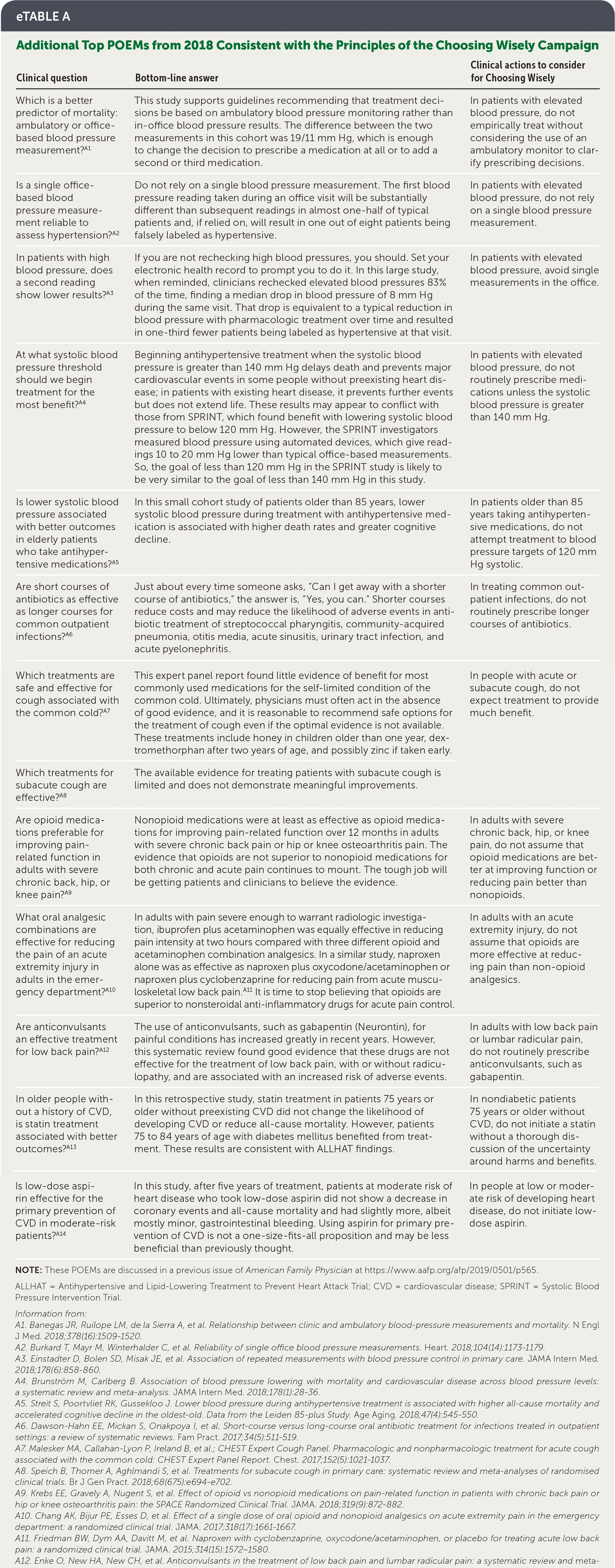
| Clinical question | Bottom-line answer | Clinical actions to consider for Choosing Wisely |
|---|---|---|
| Which is a better predictor of mortality: ambulatory or office-based blood pressure measurement?A1 | This study supports guidelines recommending that treatment decisions be based on ambulatory blood pressure monitoring rather than in-office blood pressure results. The difference between the two measurements in this cohort was 19/11 mm Hg, which is enough to change the decision to prescribe a medication at all or to add a second or third medication. | In patients with elevated blood pressure, do not empirically treat without considering the use of an ambulatory monitor to clarify prescribing decisions. |
| Is a single office-based blood pressure measurement reliable to assess hypertension?A2 | Do not rely on a single blood pressure measurement. The first blood pressure reading taken during an office visit will be substantially different than subsequent readings in almost one-half of typical patients and, if relied on, will result in one out of eight patients being falsely labeled as hypertensive. | In patients with elevated blood pressure, do not rely on a single blood pressure measurement. |
| In patients with high blood pressure, does a second reading show lower results?A3 | If you are not rechecking high blood pressures, you should. Set your electronic health record to prompt you to do it. In this large study, when reminded, clinicians rechecked elevated blood pressures 83% of the time, finding a median drop in blood pressure of 8 mm Hg during the same visit. That drop is equivalent to a typical reduction in blood pressure with pharmacologic treatment over time and resulted in one-third fewer patients being labeled as hypertensive at that visit. | In patients with elevated blood pressure, avoid single measurements in the office. |
| At what systolic blood pressure threshold should we begin treatment for the most benefit?A4 | Beginning antihypertensive treatment when the systolic blood pressure is greater than 140 mm Hg delays death and prevents major cardiovascular events in some people without preexisting heart disease; in patients with existing heart disease, it prevents further events but does not extend life. These results may appear to conflict with those from SPRINT, which found benefit with lowering systolic blood pressure to below 120 mm Hg. However, the SPRINT investigators measured blood pressure using automated devices, which give readings 10 to 20 mm Hg lower than typical office-based measurements. So, the goal of less than 120 mm Hg in the SPRINT study is likely to be very similar to the goal of less than 140 mm Hg in this study. | In patients with elevated blood pressure, do not routinely prescribe medications unless the systolic blood pressure is greater than 140 mm Hg. |
| Is lower systolic blood pressure associated with better outcomes in elderly patients who take antihypertensive medications?A5 | In this small cohort study of patients older than 85 years, lower systolic blood pressure during treatment with antihypertensive medication is associated with higher death rates and greater cognitive decline. | In patients older than 85 years taking antihypertensive medications, do not attempt treatment to blood pressure targets of 120 mm Hg systolic. |
| Are short courses of antibiotics as effective as longer courses for common outpatient infections?A6 | Just about every time someone asks, “Can I get away with a shorter course of antibiotics,” the answer is, “Yes, you can.” Shorter courses reduce costs and may reduce the likelihood of adverse events in antibiotic treatment of streptococcal pharyngitis, community-acquired pneumonia, otitis media, acute sinusitis, urinary tract infection, and acute pyelonephritis. | In treating common outpatient infections, do not routinely prescribe longer courses of antibiotics. |
| Which treatments are safe and effective for cough associated with the common cold?A7 | This expert panel report found little evidence of benefit for most commonly used medications for the self-limited condition of the common cold. Ultimately, physicians must often act in the absence of good evidence, and it is reasonable to recommend safe options for the treatment of cough even if the optimal evidence is not available. These treatments include honey in children older than one year, dextromethorphan after two years of age, and possibly zinc if taken early. | In people with acute or subacute cough, do not expect treatment to provide much benefit. |
| Which treatments for subacute cough are effective?A8 | The available evidence for treating patients with subacute cough is limited and does not demonstrate meaningful improvements. | |
| Are opioid medications preferable for improving pain-related function in adults with severe chronic back, hip, or knee pain?A9 | Nonopioid medications were at least as effective as opioid medications for improving pain-related function over 12 months in adults with severe chronic back pain or hip or knee osteoarthritis pain. The evidence that opioids are not superior to nonopioid medications for both chronic and acute pain continues to mount. The tough job will be getting patients and clinicians to believe the evidence. | In adults with severe chronic back, hip, or knee pain, do not assume that opioid medications are better at improving function or reducing pain better than nonopioids. |
| What oral analgesic combinations are effective for reducing the pain of an acute extremity injury in adults in the emergency department?A10 | In adults with pain severe enough to warrant radiologic investigation, ibuprofen plus acetaminophen was equally effective in reducing pain intensity at two hours compared with three different opioid and acetaminophen combination analgesics. In a similar study, naproxen alone was as effective as naproxen plus oxycodone/acetaminophen or naproxen plus cyclobenzaprine for reducing pain from acute musculoskeletal low back pain.A11 It is time to stop believing that opioids are superior to nonsteroidal anti-inflammatory drugs for acute pain control. | In adults with an acute extremity injury, do not assume that opioids are more effective at reducing pain than non-opioid analgesics. |
| Are anticonvulsants an effective treatment for low back pain?A12 | The use of anticonvulsants, such as gabapentin (Neurontin), for painful conditions has increased greatly in recent years. However, this systematic review found good evidence that these drugs are not effective for the treatment of low back pain, with or without radiculopathy, and are associated with an increased risk of adverse events. | In adults with low back pain or lumbar radicular pain, do not routinely prescribe anticonvulsants, such as gabapentin. |
| In older people without a history of CVD, is statin treatment associated with better outcomes?A13 | In this retrospective study, statin treatment in patients 75 years or older without preexisting CVD did not change the likelihood of developing CVD or reduce all-cause mortality. However, patients 75 to 84 years of age with diabetes mellitus benefited from treatment. These results are consistent with ALLHAT findings. | In nondiabetic patients 75 years or older without CVD, do not initiate a statin without a thorough discussion of the uncertainty around harms and benefits. |
| Is low-dose aspirin effective for the primary prevention of CVD in moderate-risk patients?A14 | In this study, after five years of treatment, patients at moderate risk of heart disease who took low-dose aspirin did not show a decrease in coronary events and all-cause mortality and had slightly more, albeit mostly minor, gastrointestinal bleeding. Using aspirin for primary prevention of CVD is not a one-size-fits-all proposition and may be less beneficial than previously thought. | In people at low or moderate risk of developing heart disease, do not initiate low-dose aspirin. |
Musculoskeletal Conditions
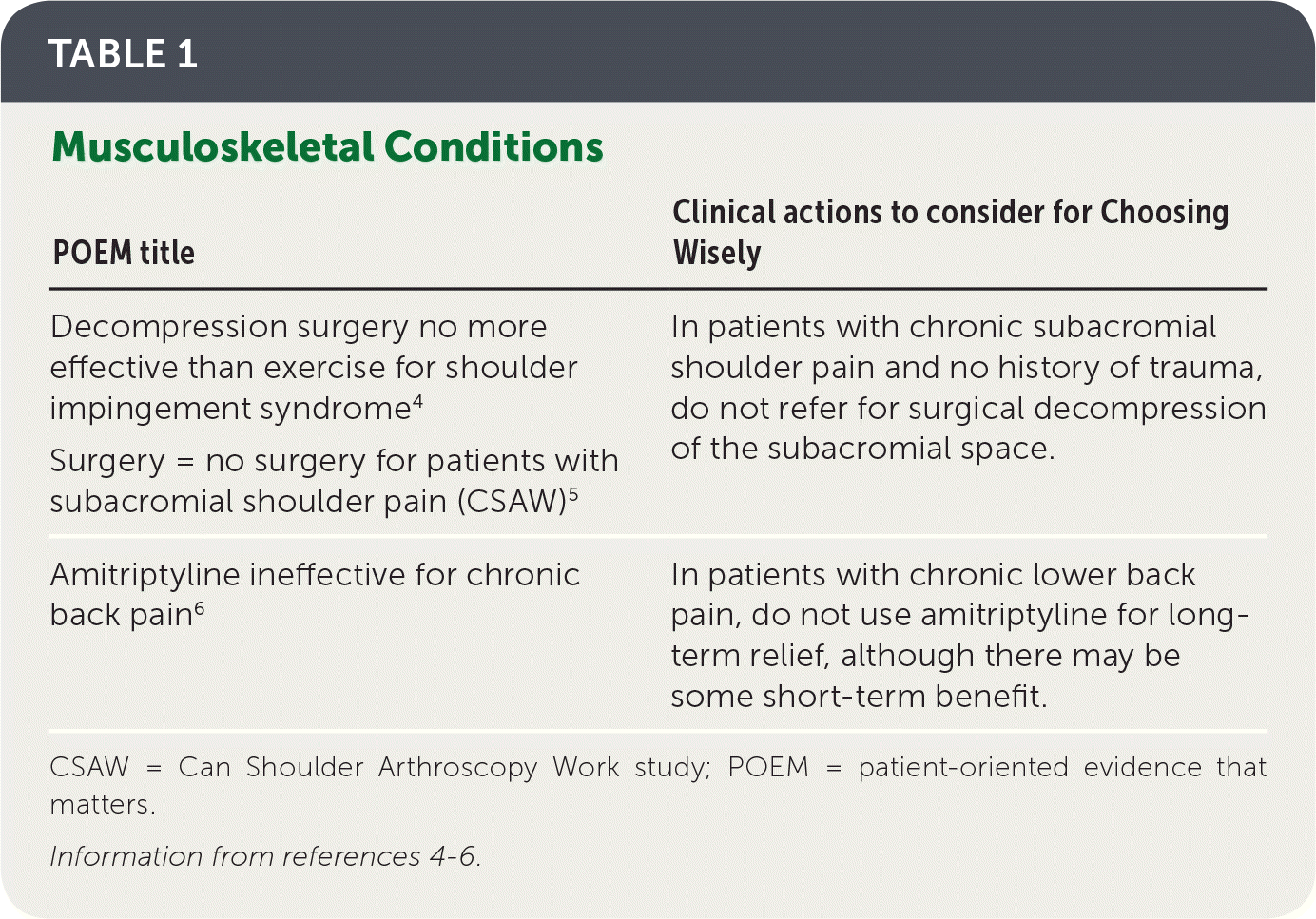
| POEM title | Clinical actions to consider for Choosing Wisely |
|---|---|
| Decompression surgery no more effective than exercise for shoulder impingement syndrome4 | In patients with chronic subacromial shoulder pain and no history of trauma, do not refer for surgical decompression of the subacromial space. |
| Surgery = no surgery for patients with subacromial shoulder pain (CSAW)5 | |
| In patients with chronic subacromial shoulder pain and no history of trauma, do not refer for surgical decompression of the subacromial space. | |
| Amitriptyline ineffective for chronic back pain6 | In patients with chronic lower back pain, do not use amitriptyline for long-term relief, although there may be some short-term benefit. |
CHRONIC SHOULDER PAIN
Subacromial shoulder pain, located near the top and lateral side of the shoulder, is common in middle age. Worldwide, arthroscopic subacromial decompression is the most common shoulder surgery. In 2018, two well-conducted randomized controlled trials summarized as POEMs reported no symptom benefit from decompression surgery compared with physical therapy or noncorrective surgery.
The Finnish Subacromial Impingement Arthroscopy Controlled Trial enrolled adults with an impingement syndrome and no evidence of a rotator cuff tear on magnetic resonance imaging.4 Participants were enrolled if they had not responded to at least three months of conventional treatment, such as steroid injection. They were randomized to physical therapy or surgery, with the surgical group further randomized in the operating room to subacromial decompression or diagnostic arthroscopy with no decompression. No difference in pain or function scores was noted after up to two years. However, patients in all three groups reported a large decrease in pain over time. A video summarizing the findings of the trial is available at https://www.bmj.com/content/362/bmj.k2860/rr-9.
The Can Shoulder Arthroscopy Work study also failed to demonstrate a benefit of arthroscopic subacromial decompression over a placebo surgery.5 Both trials failed to identify a subgroup of patients with subacromial pain who benefited enough from subacromial decompression to justify the harms. Consequently, in 2019, a panel assembled by the British Medical Journal made a strong recommendation against surgery, concluding that almost all informed patients would choose to avoid surgery because surgery is burdensome, there is no benefit, and there are harms.7
CHRONIC LOWER BACK PAIN
For many years, amitriptyline has been prescribed for difficult-to-treat painful conditions such as chronic lower back pain. In a randomized clinical trial of 146 participants with chronic lower back pain, amitriptyline (25 mg per day) was compared with benztropine (1 mg per day), a similar mouth-drying placebo.6 No improvement in pain, disability, or work outcomes was demonstrated at six months. However, there was a reduction in disability at three months, and minimal adverse events were reported in the treatment group. For Choosing Wisely, it may still be worth a three-month trial of low-dose amitriptyline for patients living with chronic back pain, given the limited pharmacologic alternatives, namely cannabidiol, opioids, or gabapentinoids.
Respiratory Disease
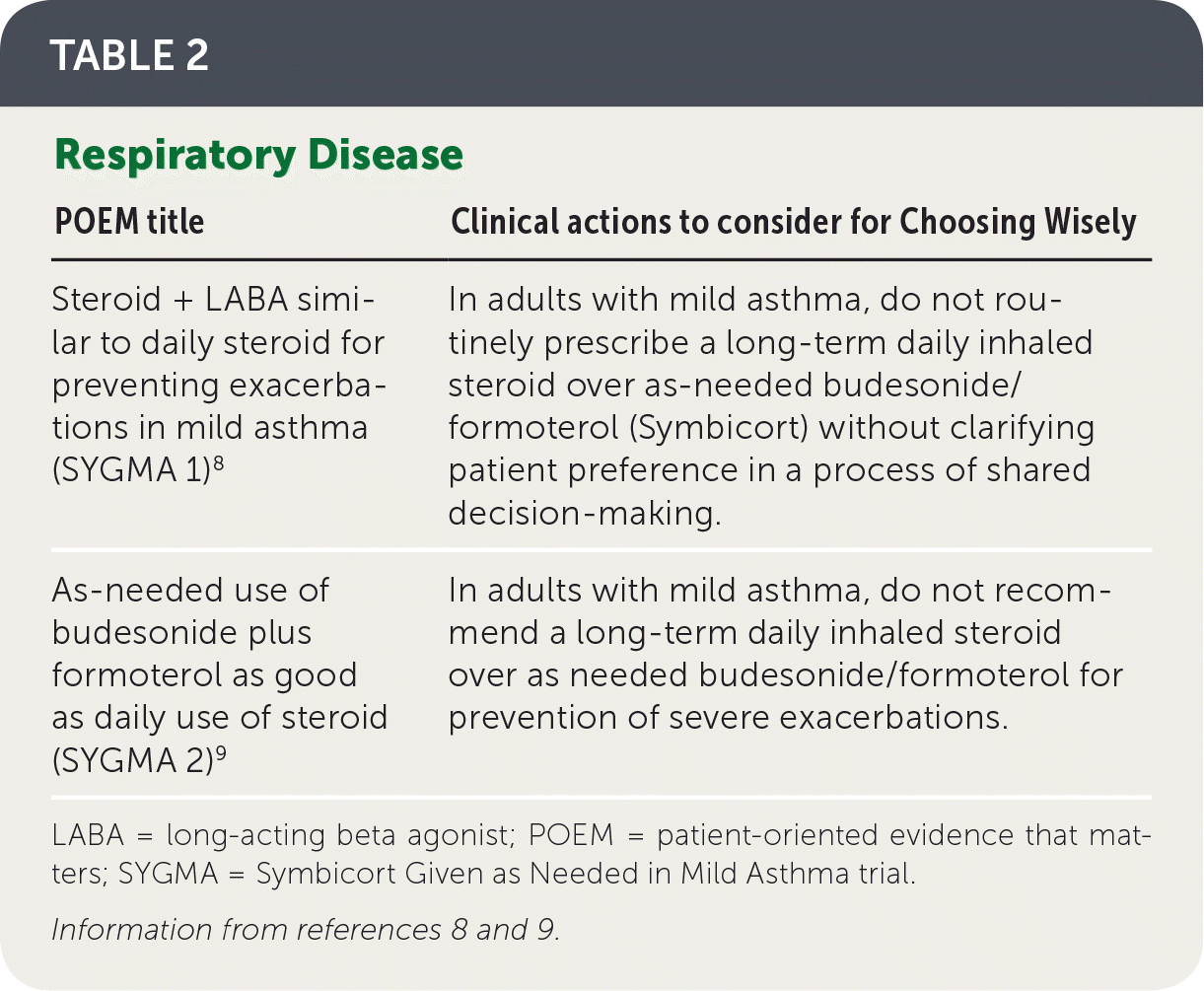
| POEM title | Clinical actions to consider for Choosing Wisely |
|---|---|
| Steroid + LABA similar to daily steroid for preventing exacerbations in mild asthma (SYGMA 1)8 | In adults with mild asthma, do not routinely prescribe a long-term daily inhaled steroid over as-needed budesonide/formoterol (Symbicort) without clarifying patient preference in a process of shared decision-making. |
| As-needed use of budesonide plus formoterol as good as daily use of steroid (SYGMA 2)9 | In adults with mild asthma, do not recommend a long-term daily inhaled steroid over as needed budesonide/formoterol for prevention of severe exacerbations. |
The SYGMA (Symbicort Given as Needed in Mild Asthma) 1 trial found that the as-needed use of an inhaled steroid plus a long-acting beta agonist is almost as effective in preventing asthma exacerbations as daily maintenance steroid therapy, and at one-fifth of the steroid dose.8 Use of an as-needed inhaled steroid plus a long-acting beta agonist (budesonide/formoterol [Symbicort], 160 mcg/4.5 mcg) or a regular daily inhaled steroid (budesonide [Pulmicort], 160 mcg twice per day) prevented asthma exacerbations, compared with as-needed inhaled terbutaline. The SYGMA 2 trial found no difference for the outcome of severe asthma exacerbation over one year between the as-needed use of budesonide/formoterol, 200 mcg/6 mcg, and the daily use of budesonide, 200 mcg, plus as-needed use of terbutaline.9
These findings are helpful for Choosing Wisely. First, unless your patient has very mild and intermittent asthma, current asthma guidelines recommend against use of a short-acting beta agonist alone.10 Second, some adults with mild asthma prefer to avoid taking inhaled steroids on a long-term daily basis. Therefore, a process of shared decision-making for inhaled steroid use is appropriate for patients with mild asthma, given the options of daily inhaled budesonide or intermittent budesonide/formoterol in a single inhaler, to reduce the cumulative steroid burden. A note of caution: other combination long-acting beta agonist/steroid inhalers have not been similarly evaluated.
Infections
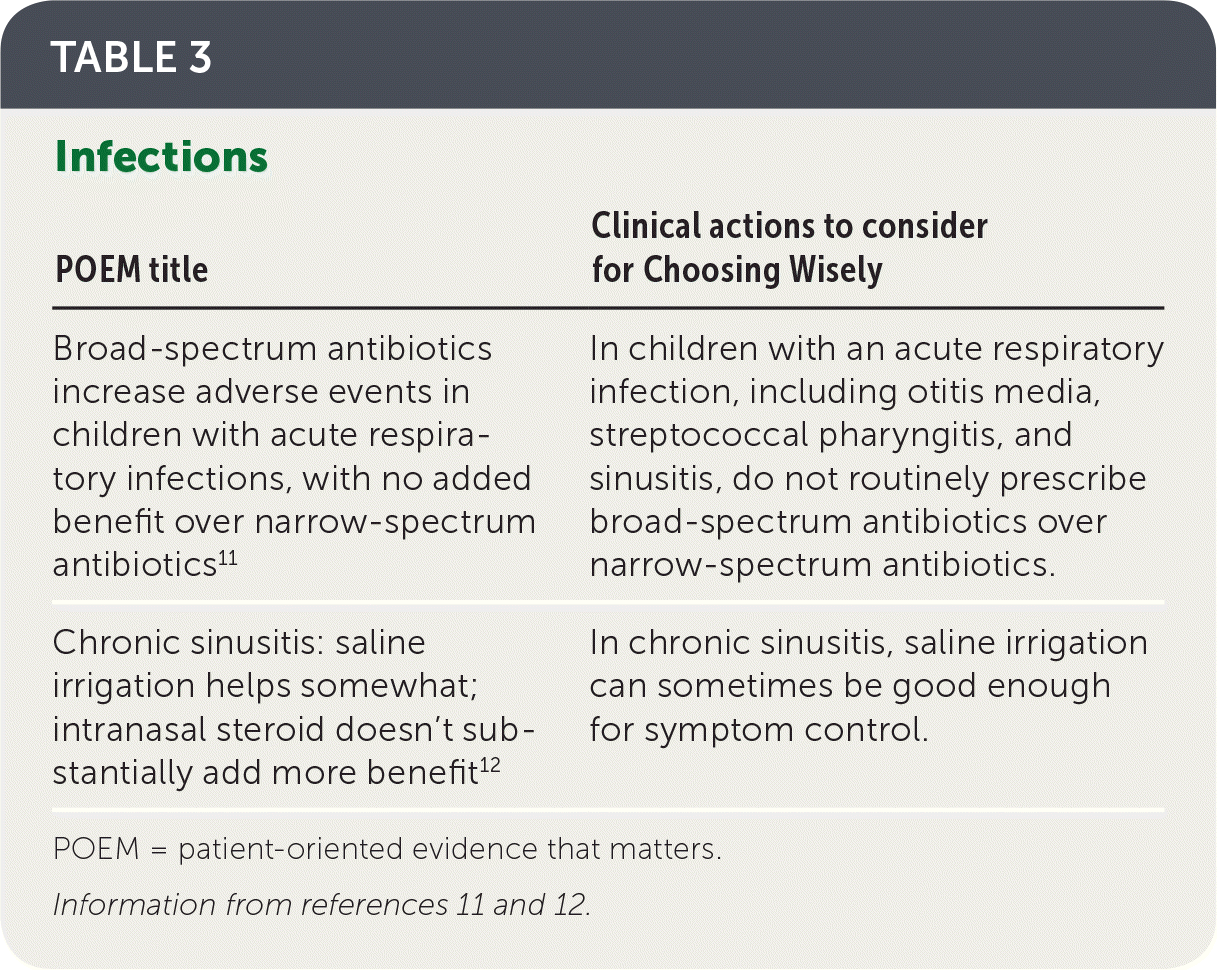
| POEM title | Clinical actions to consider for Choosing Wisely |
|---|---|
| Broad-spectrum antibiotics increase adverse events in children with acute respiratory infections, with no added benefit over narrow-spectrum antibiotics11 | In children with an acute respiratory infection, including otitis media, streptococcal pharyngitis, and sinusitis, do not routinely prescribe broad-spectrum antibiotics over narrow-spectrum antibiotics. |
| Chronic sinusitis: saline irrigation helps somewhat; intranasal steroid doesn't substantially add more benefit12 | In chronic sinusitis, saline irrigation can sometimes be good enough for symptom control. |
ACUTE RESPIRATORY TRACT INFECTIONS IN CHILDREN
It can be tempting to prescribe an empiric broad-spectrum antibiotic for children with acute respiratory tract infections in the outpatient setting. The authors of a well-designed cohort study of 30,159 children six months to 12 years of age evaluated whether broad-spectrum antibiotics are preferred over narrow-spectrum antibiotics for acute respiratory tract infections, including otitis media, streptococcal pharyngitis, and sinusitis. There was no difference in the rate of treatment failure across the groups, but more adverse events were reported by the parents of those taking broad-spectrum antibiotics.11 Adverse events included diarrhea, candidiasis, rash, other allergic reactions, and vomiting. Therefore, when antibiotics are indicated in children with acute respiratory tract infections, narrow-spectrum antibiotics are preferred.
CHRONIC SINUSITIS
Patients with chronic sinusitis have two or more of the following symptoms: mucopurulent drainage, nasal obstruction, facial pain, decreased sense of smell. First-line treatment options for chronic sinusitis are intranasal steroids and intranasal saline irrigation, usually in combination.13 For patients who hesitate to use intranasal steroids, a small trial comparing saline irrigation with placebo or an intranasal steroid showed a benefit of large-volume saline irrigation alone over 30 days in patients with chronic sinusitis of at least 12 weeks duration.12 Physicians who wish to continue prescribing intranasal steroids will not find reason to stop based on this trial, because a clinically important benefit was seen in more participants in the saline plus steroid group (79% vs. 59%; not statistically different, perhaps because of the size of the study sample).
Cardiovascular Disease
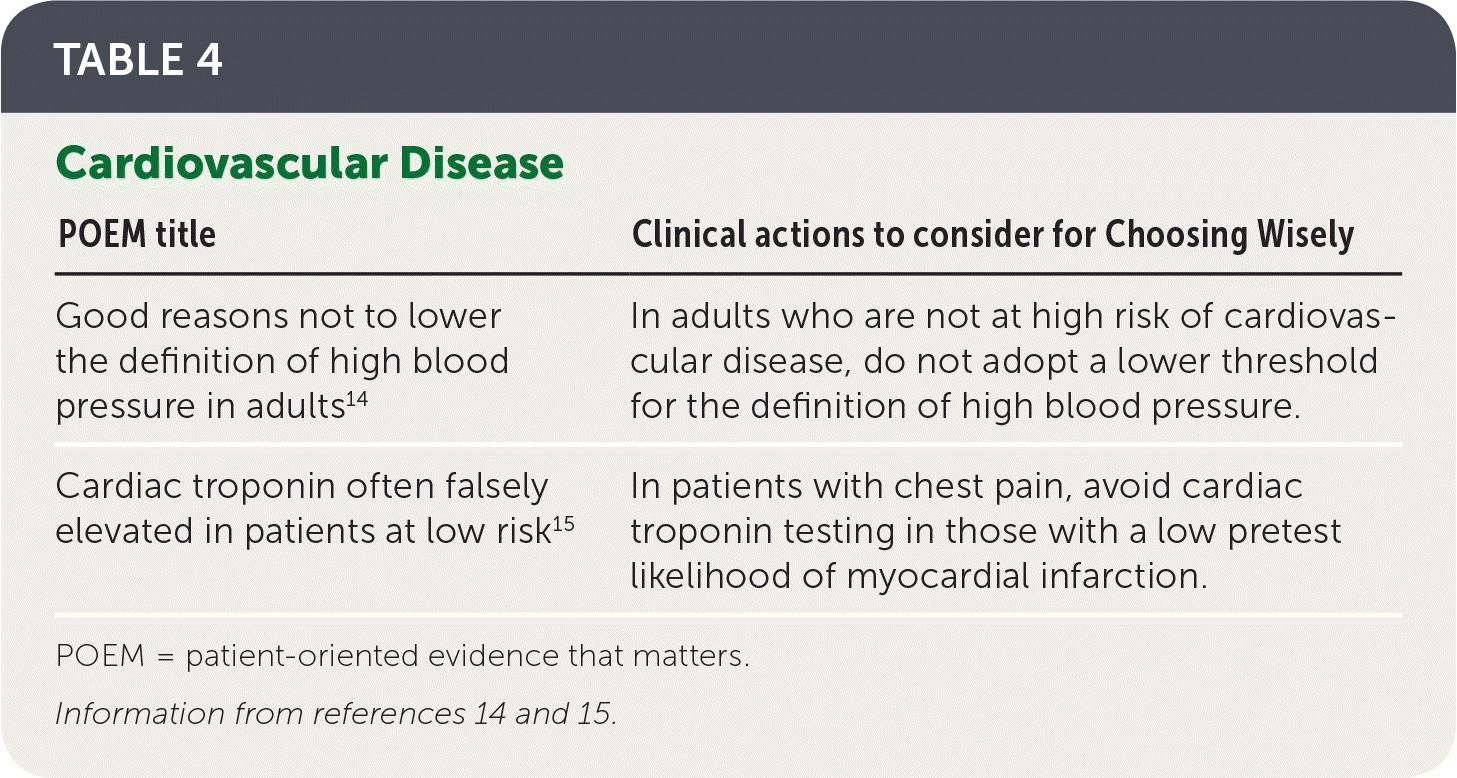
| POEM title | Clinical actions to consider for Choosing Wisely |
|---|---|
| Good reasons not to lower the definition of high blood pressure in adults14 | In adults who are not at high risk of cardiovascular disease, do not adopt a lower threshold for the definition of high blood pressure. |
| Cardiac troponin often falsely elevated in patients at low risk15 | In patients with chest pain, avoid cardiac troponin testing in those with a low pretest likelihood of myocardial infarction. |
DEFINITION OF HYPERTENSION
Is there a clear line for when hypertension should be diagnosed and treatment initiated? In a previous issue of American Family Physician, we briefly addressed the treatment component of this question based on the findings of a 2018 systematic review and meta-analysis.3,16 In a commentary on redefining disease, a checklist of criteria was applied for comparing the 2017 American College of Cardiology/American Heart Association guidelines recommending a lower blood pressure target for many patients with previous targets.14 This helped the authors evaluate the risk of overdiagnosis and overtreatment arising from a lower treatment threshold. Their findings suggest that using a lower threshold might benefit some patients at high risk of cardiovascular disease but harm patients at low risk. Taking a Choosing Wisely approach requires calculating a patient's baseline risk of cardiovascular disease and using this risk in the context of a conversation about blood pressure goals, considering the patient's personal values and preferences.
USE OF THE CARDIAC TROPONIN TEST
The high-sensitivity troponin test is a newer method to help rule out myocardial infarction (MI). A cohort study compared patients in emergency departments in the United States and the United Kingdom.15 The high-sensitivity troponin test result was elevated in about one out of eight patients (13.7%) presenting with chest pain, although the prevalence of MI was only 1.6% within 30 days of presentation. In emergency departments, the positive predictive value of an elevated troponin level for the diagnosis of MI was about 60% in the United Kingdom but only 16% in the United States. Interestingly, a negative high-sensitivity troponin test result effectively ruled out MI (negative predictive value 100%). Although effectively ruling out MI helps in safely discharging patients from the emergency department, for Choosing Wisely in practice, physicians should avoid blanketly testing patients with a low pretest likelihood of MI, because high-sensitivity troponin testing in these patients will mislead more than enlighten.
Miscellaneous
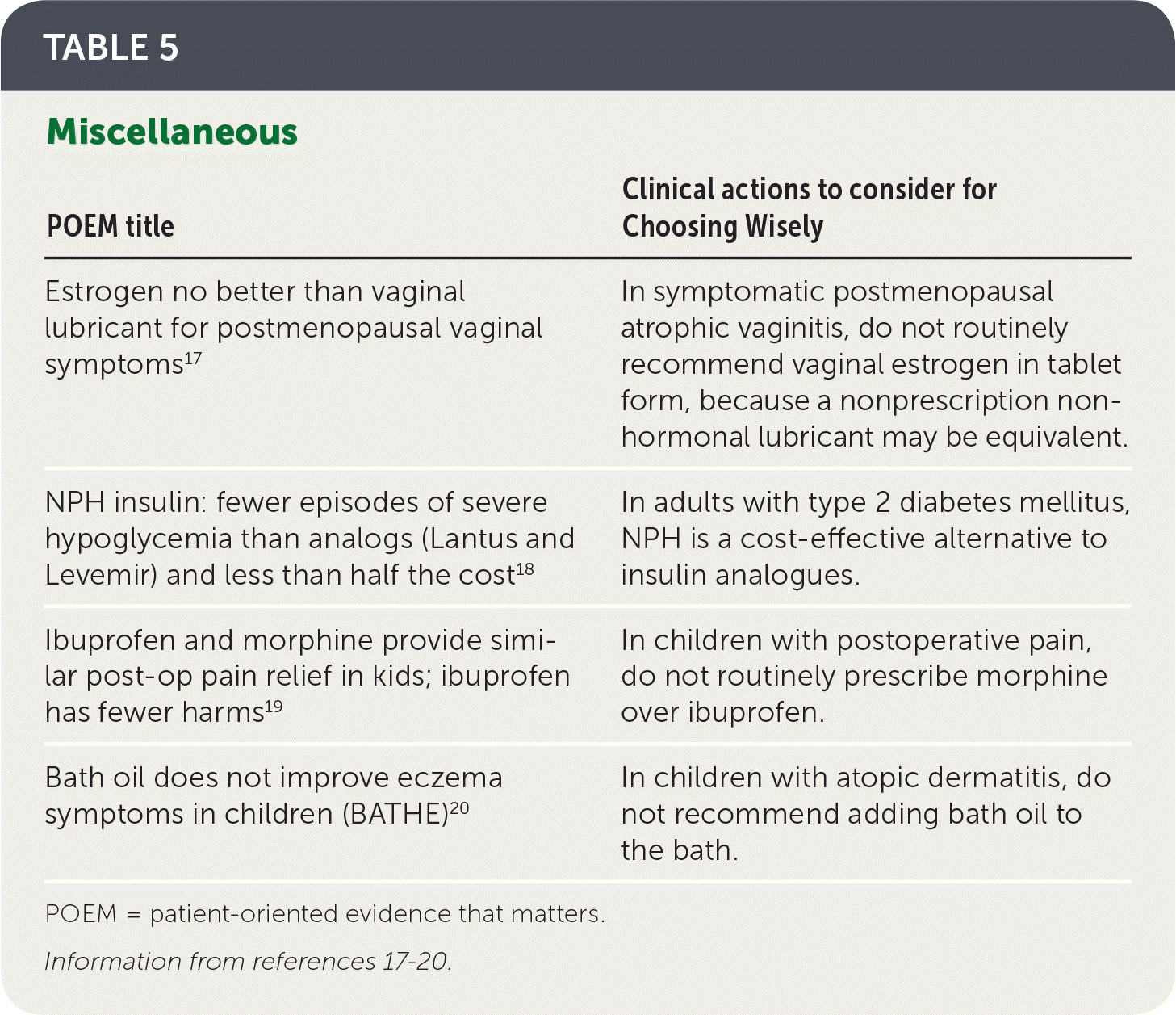
| POEM title | Clinical actions to consider for Choosing Wisely |
|---|---|
| Estrogen no better than vaginal lubricant for postmenopausal vaginal symptoms17 | In symptomatic postmenopausal atrophic vaginitis, do not routinely recommend vaginal estrogen in tablet form, because a nonprescription nonhormonal lubricant may be equivalent. |
| NPH insulin: fewer episodes of severe hypoglycemia than analogs (Lantus and Levemir) and less than half the cost18 | In adults with type 2 diabetes mellitus, NPH is a cost-effective alternative to insulin analogues. |
| Ibuprofen and morphine provide similar post-op pain relief in kids; ibuprofen has fewer harms19 | In children with postoperative pain, do not routinely prescribe morphine over ibuprofen. |
| Bath oil does not improve eczema symptoms in children (BATHE)20 | In children with atopic dermatitis, do not recommend adding bath oil to the bath. |
POSTMENOPAUSAL ATROPHIC VAGINITIS
Do you routinely recommend nonprescription nonhormonal lubricants before vaginal estrogen for patients with symptomatic postmenopausal atrophic vaginitis? Some women prefer to avoid estrogen. A trial of 302 postmenopausal women with painful intercourse, dryness, or itching showed that less-expensive and lower-risk lubricants (e.g., Replens) are equally effective as vaginal estrogen tablets, 10 mcg.17 About one-half of the women in each group experienced improvement, defined by a clinically important change in scores on a four-point scale. Of note, this study does not evaluate whether estrogen as a cream or at a higher dose could provide greater benefit.
NPH INSULIN
In a cohort study of patients with type 2 diabetes mellitus, NPH insulin was found to meet the STEPS (Safety, Tolerability, Effectiveness, Price, Simplicity) criteria, except for simplicity because of the twice daily dosing, when compared with long-acting insulin analogues (e.g., glargine [Lantus], detemir [Levemir]).18 For Choosing Wisely, this study reminds us that the new is not necessarily better than the old.
IBUPROFEN VS. MORPHINE FOR POSTOPERATIVE PAIN IN CHILDREN
A carefully designed and adequately powered randomized controlled trial found no difference in pain reduction between ibuprofen, 10 mg per kg, and oral morphine, 0.5 mg per kg, in children who underwent minor outpatient orthopedic surgery (most commonly hardware removal, open reduction and internal fixation of a fracture, or arthroscopy). Adverse effects, primarily nausea, vomiting, drowsiness, and dizziness, were much more likely with morphine.19
BATH OIL
In children with atopic dermatitis, a well-designed trial using a seven-question patient-oriented eczema measure found no benefit from adding an oil-based emollient to bath water.20 Skipping the bath oil will decrease the risk of harm from a slip in an oily bathtub.
Editor's Note: This article was cowritten by Dr. Mark Ebell, who is deputy editor for Evidence-Based Medicine for AFP and cofounder and editor-in-chief of Essential Evidence Plus, published by Wiley-Blackwell, Inc. Because of Dr. Ebell's dual roles and ties to Essential Evidence Plus, the article underwent peer review and editing by four of AFP's medical editors. Dr. Ebell was not involved in the editorial decision-making process. —Sumi M. Sexton, MD, Editor-in-Chief
See the Top POEMs from previous years at https://www.aafp.org/afp/toppoems.
